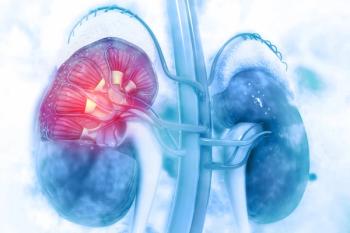
Pazopanib Noninferior to Sunitinib for Metastatic RCC
A head-to-head comparison of pazopanib and sunitinib for the treatment of metastatic renal cell carcinoma showed that the two drugs resulted in similar progression-free survival, but also indicated that pazopanib may have a favorable safety profile.
A head-to-head comparison of pazopanib and sunitinib for the treatment of metastatic renal cell carcinoma showed that the two drugs resulted in similar progression-free survival, but also indicated that pazopanib may have a favorable safety profile.
The results of the comparison were
Seven drugs have been approved by the FDA for the treatment of clear-cell, metastatic renal cell carcinoma in recent years. This study was the first to compare pazopanib and sunitinib head to head.
“With multiple, approved treatment options available for metastatic renal-cell cancer, head-to-head comparisons are needed to inform the choice of treatment,” wrote researchers led by Robert J. Motzer, MD, of the department of medicine at Memorial Sloan-Kettering Cancer Center. “When agents with similar efficacy are options for first-line therapy, the safety profile assumes great importance in determining treatment choice.”
The trial examined outcomes with the two drugs in 1,110 patients randomly assigned to 800 mg once daily pazopanib (n = 557) or 50 mg sunitinib once daily for 4 weeks followed by 2 weeks without treatment (n = 553).
Results of the progression-free survival analysis showed no significant difference between the two drugs (HR = 1.05; 95% CI, 0.90–1.22). Median progression-free survival for pazopanib was 8.4 months compared with 9.5 months for sunitinib. In addition, no difference was found for overall survival for patients assigned either drug (HR = 0.91; 95% CI, 0.76–1.08).
“However, the safety profiles of the two drugs differed,” the researchers wrote. “Most adverse events, particularly those associated with discomfort, such as fatigue, the hand-foot syndrome, and mouth sores, occurred more frequently with sunitinib than with pazopanib.”
A comparison of these adverse events showed worse outcomes for sunitinib:
• Fatigue: 55% for pazopanib vs 63% for sunitinib
• Hand-foot syndrome: 29% for pazopanib vs 50% for sunitinib
• Thrombocytopenia: 41% for pazopanib vs 78% for sunitinib
Higher incidence of increased levels of alanine aminotransferase was noted in patients with pazopanib.
Dr. Motzer and colleagues also looked at quality-of-life outcomes in patients assigned the two drugs. Patients assigned to pazopanib had statistically significant improvements in 11 of 14 domains examined during the first 6 months of treatment, including fatigue or soreness in the mouth, throat, hands, or feet.
According to the researchers, the quality-of-life findings were supported by another study presented at two oncology meetings in 2012 that found that “patients treated with pazopanib reported having less fatigue, soreness of the hand or foot, and soreness of the mouth or throat than did patients treated with sunitinib.”
References:
Escudier B, Porta C, Bono P, et al. Patient preference between pazopanib and sunitinib: results of a randomized double-blind, placebo-controlled, crossover study in patients with metastatic renal cell carcinoma (mRCC) (PISCES Study -NCT 01064310). Presented at the Annual Meeting of the American Society of Clinical Oncology, Chicago, June 1–5, 2012.
Cella D, Kaiser K, Beaumont J, et al. Quality of life (QoL) among renal cell carcinoma (RCC) patients in a randomized double blind cross-over patient preference study of pazopanib (P) versus sunitinib (S). Presented at the European Society of Medical Oncology Congress, Vienna, September 28–October 2, 2012.
Newsletter
Stay up to date on recent advances in the multidisciplinary approach to cancer.





















































































